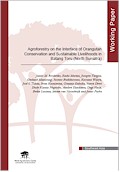| Working Paper Series |
 |
|
| Title | Agroforestry on the Interface of Orangutan Conservation and Sustainable Livelihoods in Batang Toru (North Sumatra) | | Author | James M Roshetko | | Year | 2007 | | Publisher | World Agroforestry Centre - ICRAF, SEA Regional Office | | City of Publication | Bogor, Indonesia | | Series Number | Working Paper no. 56 | | Number of Pages | 26 | | Call Number | WP0091-08 | | Keywords | Community-based conservation, agroforestry livelihood systems, sustainable economic
alternatives, conservation-livelihood strategies, land tenure assessment, spatial analysis,
agroforestry extension. |
|
| Abstract: |
| The Batang Toru area in North Sumatra supports the largest population of Sumatran Orangutan outside of formal conservation areas, as well as, a large human population. ICRAF and Winrock International analyzed the rich agroforestry livelihood systems of the area to: strengthen local support for conservation-based income alternatives to destructive forest practices; and catalyze local entrepreneurs to create sustainable economic alternative activities. The ICRAF-Winrock team conducted socioeconomic, land tenure assessment, spatial analysis, macroeconomic, and market studies to identify key threats, opportunities and the communities best positioned and most interested to collaborate in the effort. The Conservation and Livelihood Index was developed as a spatial analysis tool for landuse based negotiations between stakeholders. Five focal communities were selected and priority agroforestry crops identified as rubber (Hevea brasiliensis), cacao (Theobroma cacao), sugar palm (Arenga pinnata), durian (Durio zibethinus) and fruit and vegetable tree-products. The Team worked with participating farmer groups in each focal community to develop community priorities, enhance agroforestry skills, strengthen conservation awareness, and develop market understanding and linkages. An agroforestry extension approach evolved that held biweekly meetings with focal communities and utilized international, national, and local (farmer) technical and private sector specialists. Achievements include: over 1300 farmers trained at 13 events, rubber and cacao production increased by 10- 15%, 6 new farmer enterprises developed to increase household incomes, and 5 communities developed livelihood-conservation strategies. Key lessons learned include: traditional agroforestry livelihood systems are compatible with orangutan habitat conservation; ignoring valid land claims, particularly from conservation-minded communities, risks an escalation of tension and possible conflict that may make conservation efforts counter-productive; and conservation-livelihood strategy agreements are a valuable tool to achieve both community livelihood objectives and public conservation goals. |
|